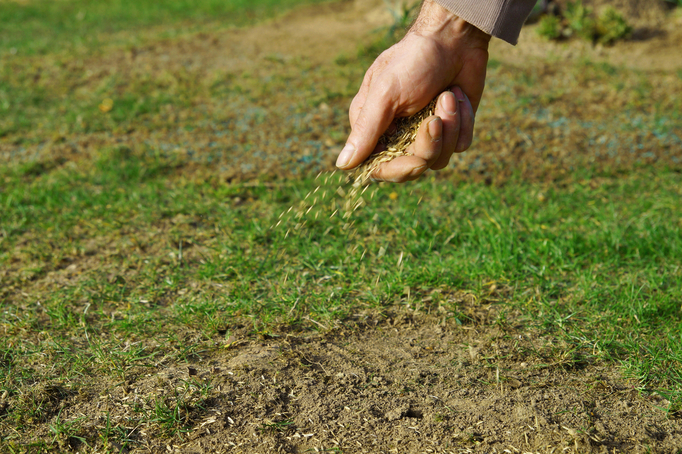The best time to seed a lawn depends on the type of grass you’re planting, the condition of your existing lawn, and the climate and weather patterns in your region. Seeding your lawn in the wrong season or at suboptimal conditions can waste all the hard work and costs you put into it, and you will end up right back where you started.
This post will help you understand why timing matters when it comes to seeding your lawn for healthy and long-lasting turf!

Warm-season grasses, such as Bermudagrass, Zoysiagrass, St. Augustinegrass, and Centipedegrass, thrive in regions with hot summers and mild winters. The best time to seed warm-season grasses is in late spring to early summer when soil temperatures reach at least 65°F. Warm-season grass seeds need consistent warmth to germinate, making late spring ideal because soil temperatures remain steady and the risk of frost has passed.
Planting warm-season grass too early, when soil temperatures are still cool, can slow down germination and increase the risk of fungal diseases. On the other hand, seeding too late in summer can leave new grass struggling to establish before fall, when cooler temperatures start to slow growth. The key is to seed when daytime temperatures range between 80-95°F, ensuring rapid germination and strong root development before summer heat peaks.
Benefits Of Seeding In Spring:
To improve germination rates, prepare the soil by removing debris, loosening compacted areas, and ensuring adequate moisture. Water new seed frequently, keeping the topsoil moist but not overly saturated. A light layer of straw or mulch can help retain moisture and protect the seeds from being washed away by heavy rain.

For cool-season grasses like Kentucky bluegrass, tall fescue, fine fescue, and perennial ryegrass, fall is the best time for seeding. The ideal window typically falls between late August and mid-October, depending on your region. Fall seeding takes advantage of cooler air temperatures while the soil remains warm from summer, creating the perfect conditions for germination and root development.
Seeding in fall allows the grass to establish strong roots before winter dormancy. By the time spring arrives, your lawn will have a well-developed root system capable of supporting healthy, vigorous growth. Fall seeding also helps reduce weed competition, as many common weeds begin to die off when temperatures drop.
Benefits Of Seeding In Fall:
When seeding in fall, aim for a time when daytime temperatures range between 60-75°F. Water regularly, keeping the soil consistently moist but not soggy. Since weeds are less aggressive in fall, your new grass will have a better chance of establishing itself without competing for nutrients and water. If possible, apply a starter fertilizer rich in phosphorus to promote strong root growth.

Seeding a new lawn and overseeding an existing one require different approaches, even though both involve planting grass seed. New lawn seeding is the process of establishing a lawn from bare soil, which requires extensive soil preparation, including grading, soil amendments, and initial fertilization. This method is best when starting from scratch, whether you’re creating a lawn in a newly built home or replacing an old, damaged lawn.
Overseeding, on the other hand, is the practice of spreading new grass seed over an existing lawn to improve density, fill in bare spots, and introduce new grass varieties for better resilience. Overseeding does not require completely removing the existing lawn but does involve preparing the soil by mowing low, raking to remove thatch, and aerating if necessary.
A key difference between the two methods is seed-to-soil contact. With new lawn seeding, seed is applied to loose soil, making it easier for roots to establish. In overseeding, existing grass can create competition for water and nutrients, making preparation essential for success. Both methods require proper watering and fertilization, but overseeding generally has faster results because the existing lawn provides some protection for the new seedlings.

Even a well-maintained lawn can thin out over time due to environmental stress, foot traffic, pests, and disease. Overseeding is an effective way to restore density and improve the overall appearance of your lawn. Though overseeding schedules should follow the same timeline as new lawn seeding, overseeding can be performed whenever your lawn is looking sparse. Keep the warning signs below in mind to let you know it is time to overseed.

Aeration and seeding go hand in hand, especially when overseeding an existing lawn. Lawn aeration involves creating small holes in the soil to alleviate compaction, improve air circulation, and enhance water and nutrient absorption. When done before seeding, aeration provides the perfect conditions for new grass seed to establish strong roots. The holes made by core aeration even allow little pockets at the perfect depth for grass seed germination.
Aeration helps break up thatch, a dense layer of organic material that can prevent seed from reaching the soil. Aeration increases germination rates and improves overall seedling success by allowing better seed-to-soil contact when the thatch layer is managed properly. It also enhances root growth by reducing soil compaction, which can restrict water and nutrient uptake.

Seeding at the right time makes all the difference between a thick, thriving lawn and weak or patchy growth. Professional lawn care services have the expertise to know exactly how and when to seed to ensure even coverage and full grass growth. Call Easy Lawn Care in South Carolina today, and let us help you achieve the beautiful lawn you have always wanted!